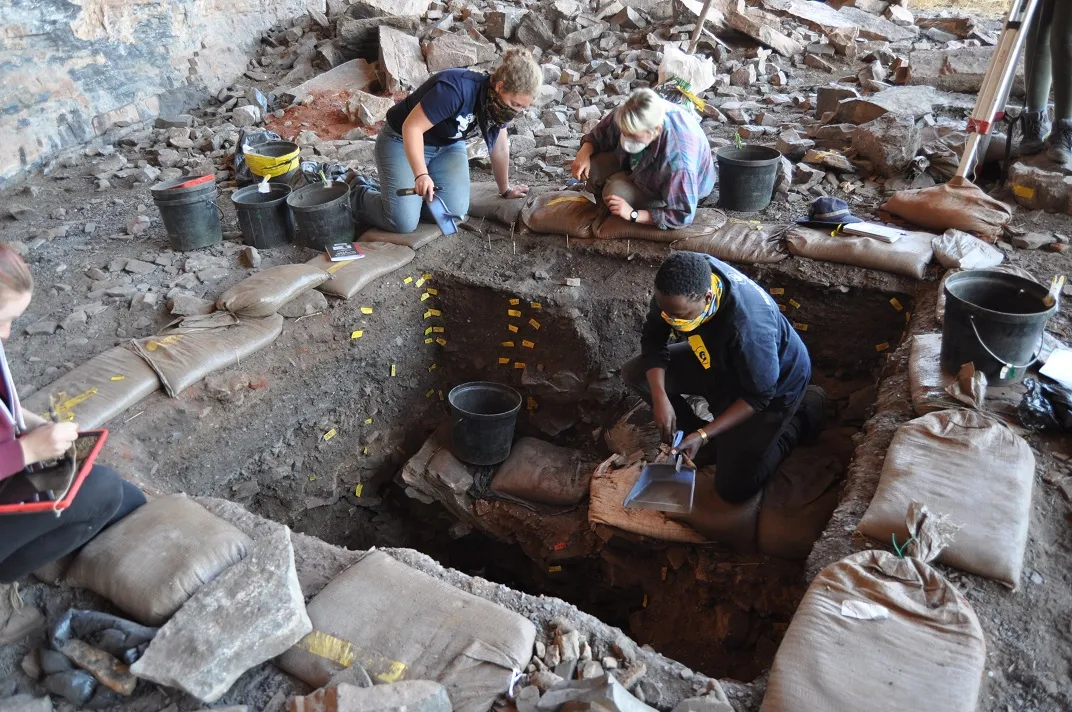Crystals Found in Kalahari Desert Challenge Assumptions About Where in Africa Human Culture Arose
The 105,000-year-old items may have held religious meaning
/https://tf-cmsv2-smithsonianmag-media.s3.amazonaws.com/filer/1a/e3/1ae31ed2-8eec-41cf-976a-05644bd79c1e/crystals2.jpg)
The discovery of extremely old stone-age tools and crystals at a rock shelter in the southern Kalahari Desert may change scientists’ understanding of early human culture in Africa.
The 105,000-year-old items found at the inland site of Ga-Mohana Hill in South Africa reflect cultural development on par with previously reported human activity on Africa’s coast around the same time period, Science News’s Bruce Bower reports. Because few sites of human cultural activity are known from that long ago it’s unclear whether the developments in different regions are related or emerged independently.
“Our findings from this rockshelter show that overly simplified models for the origins of our species are no longer acceptable,” Jayne Wilkins, an archaeologist at Griffith University in Australia who led the new study, says in a statement. “Evidence suggests many regions across the African continent were involved, the Kalahari being just one.”
The new finds, reported in the journal Nature, include stone tools, bones with signs of butchery, and ostrich eggshell fragments. The researchers believe ancient people modified the shells for use as water vessels, as discoveries from later time periods have suggested.
The team also found a collection of 22 white calcite crystals. After ruling out geological explanations for the crystals’ presence in the cave, they concluded that humans must have brought them there, although they don’t have an obvious use.
“Walking around with a crystal in your pocket isn’t going to help you to get a meal or find water,” study coauthor Benjamin Collins, an anthropologist at the University of Manitoba, tells the Globe and Mail’s Ivan Semeniuk.
The team concluded that the ancient people may have valued the crystals for their beauty, and for cultural or religious reasons.

“Crystals found across the planet and from several time periods have previously been linked to humans’ spiritual belief and ritual,” Wilkins and coauthor Sechaba Maape, an architect at the University of the Witwatersrand in Johannesburg, South Africa, write at The Conversation. “This includes in southern Africa.”
The site of the discoveries, Ga-Mohana Hill, holds spiritual significance for modern people in the surrounding towns, and the finds suggest it might have had somewhat similar uses in ancient times.
“The crystals point towards spiritual or cultural use of the shelter 105,000 years ago,” Maape says in the statement. “This is remarkable considering that site continues to be used to practice ritual activities today.”
At the time that the artifacts date to, the area was much wetter than it is today, but probably still more difficult a place to live than the coasts. Some researchers have previously suggested that the seafood and other resources available in coastal communities led to the development of higher thought and innovative behaviors, but the new study suggests this may not be the case.
“I think what it does is demystify the coastline as a source of innovation,” Genevieve Dewar, an anthropologist at the University of Toronto who is not involved in the research, tells the Globe and Mail. “It’s not always going to be the case that people innovate [only] when life is great.”
Wilkins and Maape write that, since the site continues to have ritual purposes, the team is careful not to leave visible traces of their excavation, back-filling the area during the seasons when they’re not working there.
“From an archaeological perspective, we believe this approach will help ensure Ga-Mohana Hill can continue to offer new and valuable insights into the evolution of Homo sapiens in the Kalahari,” they write.
/https://tf-cmsv2-smithsonianmag-media.s3.amazonaws.com/accounts/headshot/Livia_lg_thumbnail.png)
/https://tf-cmsv2-smithsonianmag-media.s3.amazonaws.com/accounts/headshot/Livia_lg_thumbnail.png)